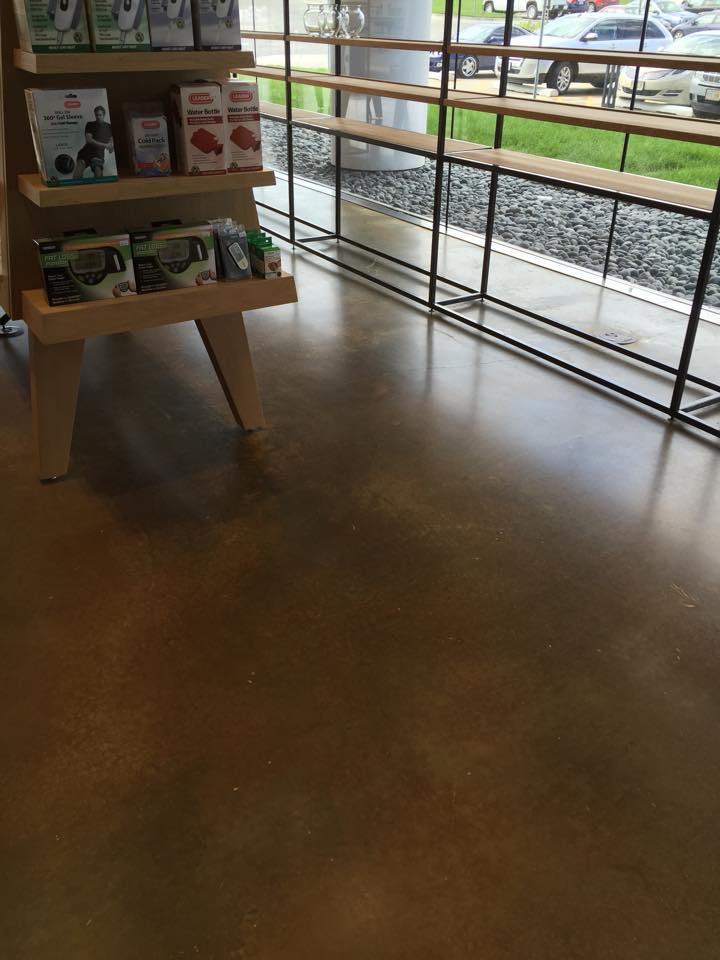
![]()
One of the best ways to achieve colored concrete is to use stain, especially if you want more earth tone colors. While there is a lot that goes into staining concrete, over all, there are four basic steps used for acid stains, which if followed should eliminate common problems with staining concrete.
Step 1. First you want to prepare the surface. Knowing how the concrete is going to react to the stain is important. This step is very important, so you want to make sure it’s completed right, or you will be spending more time and money to correct problems later on. You can do a simple water test by spraying water on the concrete to see what happens. This will tell you a lot about how porous the concrete is and it’s ability to absorb the stain. Look for dry spots or areas of beading water. If the water absorption is even then this will indicate that further prep work is needed. Three common ways to prep for staining are sanding, mineral acid cleaning, and chemical degreasers. These help to open up the surface for the stain to be better able to penetrate the concrete. Moisture vapor emission tests also can be used during this stage. This test will tell you how much moisture vapor is coming from the slab. Penetration is inhibited if there’s too much moisture.
Step 2. Next you will apply the stain. This is actually the easiest step. One gallon of most stains cover 250-300 square feet. Be careful not to over apply the stain or it can result in build up or create surface tension, particularly when working with less porous concrete surfaces as well as when using darker hued stains. One option is to use a broom or walk behind scrubber to apply the stain to better penetrate the surface. You want to let the stain ‘self heal’ after applying the stain with a broom or scrubber, this will allow the stain to distribute into one even layer, getting rid of any marks from application. If a darker shade is desired you can repeat this process after about five hours of dwell time.
Step 3. Now you will want to neutralize and wash the acid based stain. This step is often overlooked and misunderstood. When applying an acid stain concrete goes from a basic pH state to an acid state. Therefore, after the stain is applied you will need to make the concrete return to basic and eliminate any excess unreacted stain and residue. This can be done using an alkaline soap and a scrubber to clean concrete of any stain residue and to neutralize the concrete surface. Water alone will not suffice. You will again want to use a broom or scrubber for this process and may need to clean the surface multiple times to ensure that the concrete is neutral. Terracotta and darker brown stains typically need multiple cleanings to achieve this. A pH test can be used to ensure that the concrete is neutral. Before you move on to sealing you will want to rinse the concrete with clean water and allow the concrete to dry thoroughly.
Step 4. Finally we suggest sealing the stained concrete floor. This will keep the stain looking it’s best. You will want to use a system to seal the floor and not simply a seal by itself. The system includes a base coat and a sacrificial topcoat or wax.
Variations of the above steps are common so you want to ensure that you are following product instructions and we recommend using an area to sample the stain, this will be the best way to see what the stain will look like. You will obviously want to sample an area that is not going to be seen. You can always consult with the stain manufacturer for further details and guidelines.
There are so many creative and custom options for finishing concrete, but first and foremost important is the concrete itself. At Custom Concrete Creations we have state of the art equipment and a properly trained team with years of experience. Custom Concrete Creations is a premier contractor serving the Omaha area as well at the Midwest. Give us a call or send us an email for your custom concrete finishing needs today!
